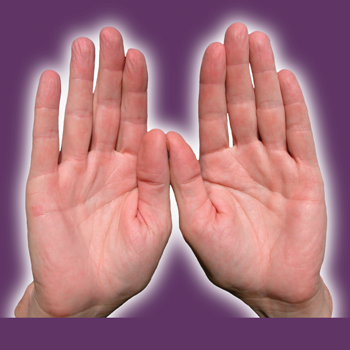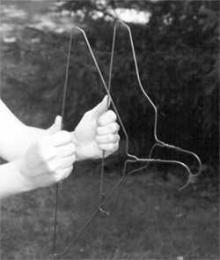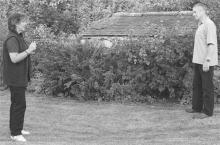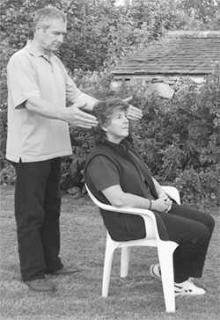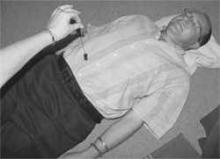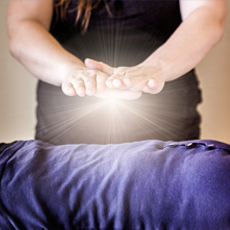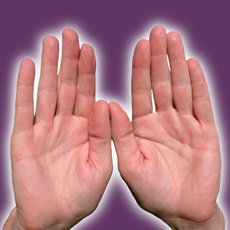by Penny Quest
Reiki And Energy
Although it certainly isn’t essential to know a lot about the human energy field (auras and chakras) in order to use Reiki effectively, I find that it helps my students enormously if they first gain an understanding of thebody’s natural energy system before I begin to explain about Reiki. Of course we know that Reiki is an energy—the word means spiritual energy or universal life-force energy—and when we use it in healing, it acts holistically, affecting all of the energies which comprise the human body, or animals, or anything else in the natural world.
Einstein and later quantum physicists have explained that at an atomic level everything that exists in the universe is energy, vibrating and oscillating at different rates, and that physical matter and energy are just two forms of the same thing. Some of these energetic vibrations are very familiar to us, such as sound, light, radio waves, or X-rays. These are all part of the electromagnetic spectrum, and from a scientific perspective the only difference between these various forms of energy is that each oscillates at a different frequency or rate of vibration. The human body, and the energy field which surrounds and interpenetrates it, is also made up of electromagnetic energy, and every person has a unique vibrational energy signature, or frequency, in the same way as we all have unique fingerprints or DNA.
The electrical output of a person’s whole body can actually be measured using an electromyograph, and some interesting research was carried out on a variety of people a few years ago by Dr Valerie Hunt, author of Infinite Mind: The Science of Human Vibrations. She recorded the output at the high-energy sites on the body known as chakras, and some fascinating results were obtained. Most people in the study registered within the normal range, around 250 cps (cycles per second). But when the tests were carried out on people who used healing energies (such as Reiki) and others who actively used their psychic ability, it was found that their frequencies registered in a band between 400 and 800 cps. Even higher frequencies—more than 900 cps—were found in people who were not only healers and psychics, but also followed a very spiritual path, regularly practising deep meditation. So when we talk about Reiki raising your vibrations there is now scientific evidence to prove that is true! *Editor’s note: Please see the interview with James Oschman in this issue.
The Human Energy Body
The physical body is something we all know about—we can see it and feel it—yet every cell within it is actually energy or light, vibrating at a slow enough rate to make it into visible physical matter. However, surrounding and interpenetrating our physical body is another body of energy made up of much finer, lighter, and higher vibrations, which is usually called the aura, the auric field, or the human energy body. This auric field is as much a part of you as your physical body—indeed your physical body is really just the densest inner layer of this flowing energy field. However, the higher frequencies of the energies that make up the aura mean it is harder to see with the naked eye, although it can be detected by some scientific equipment and a representation of the aura can also be photographed using a specially developed Kirlian camera.
In addition to the aura, our energy body contains some active energy centres known as chakras, and a range of energy channels flowing through the body called meridians and nadis. Perhaps the easiest way of understanding this is to think of the energy body in similar terms to your physical body. The aura is the energy equivalent of your whole physical body, the chakras correspond to your brain and major organs, and the meridians and nadis are similar to your veins and arteries, but instead of blood, they carry energy—Ki—all over the body.
The aura is a field of energy or light that completely surrounds the physical body above, below, and on all sides. It is made up of seven layers, with the inner layers closest to the physical body comprised of the densest energy, and each succeeding layer being of finer and higher vibrations. Most people have an oval (elliptical) aura, which is slightly larger at the back than at the front and fairly narrow at the sides, and it also stretches above the head and below the feet. Your aura is not always the same size, however, as it can expand or contract depending upon a variety of factors such as how healthy you are, how you are feeling emotionally or psychologically at any given moment, or how comfortable you feel with the people in your immediate surroundings.
This aura is spiritual energy, or life-force, which is present around each of us from birth (and before birth, as the foetus develops) until around the time of our death. (Usually just before death only a narrow band of spiritual energy remains, linking all the chakras in the centre of the body, and shortly after physical death, no aura can be detected, because the life-force no longer exists.) In a living person the outer edges and the individual layers of the aura can be detected using dowsing rods or a pendulum, and they can also be sensed with the hands. The densest layers, nearest the body, can also be seen with the naked eye by most people with a little practice, and some very psychic people can see the whole energy body quite clearly. Painters over the centuries have depicted the aura around the heads of angels, saints, and prophets as a bright golden halo, indicating their pure and spiritual energy.
Detecting The Aura
Detecting auras is the first thing I teach in my Reiki classes. Apart from being great fun, it also allows people to gain a real understanding of the concept of energy and life-force before they learn to use the higher vibrations of Reiki healing energy to permeate, clear, balance, and energise the whole energy body.
The biggest shock for most people is finding out how large the aura can be! Of course it varies from person to person and it changes from day to day, but the outer layer of the aura can be anywhere from about two metres (six feet) to twenty metres (sixty-six feet) or even further away from the person’s physical body. This means that whenever we are with other people our auras are intermingling, and whether or not we are mindful of it we are picking up signals from other people’s auras all the time.
Although we may not be consciously aware of the fact, we all use our auras as sensing devices—what you might call the eyes in the back of your head. Maybe you have experienced a strange prickling sensation at the back of your neck when someone has been looking at you from behind? Or have you ever felt particularly drawn to sit next to someone, or alternatively, felt a sense of discomfort when standing next to someone else, even though you do not know that person? This could be because your aura has already picked up either complementary or disturbing energies within the other person’s aura. Perhaps you have even been able to sense the atmosphere within a room before you have opened the door? This isn’t surprising, really, when you consider that your aura may extend far ahead of you. It is made up of finer and lighter vibrations, and it can pass through the denser energy of physical matter, so it is already in the room picking up the vibrations of other people’s auric fields.
You don’t need expensive equipment to detect the aura—as I have stated, it can be done with dowsing rods or a pendulum, and it can also be sensed or felt with the hands.
Most people have heard of dowsing only in relation to finding sources of water, but dowsing is actually much more useful than that; it can be used to find virtually anything from minerals, metals, and oil to ley(?) lines, prehistoric earthworks, magnetic north, or even lost purses! Also, most people seem to think that dowsing is difficult, or that only certain people can do it, but it’s really very easy and takes only a few minutes to learn. I know, having shown hundreds of people how to do it.
The theory behind dowsing is also simple. Dowsing rods are usually made of a Y-shaped piece of hazel wood or from pieces of metal, and the ones I use in my classes are made of old metal coat-hangers, the type you often get with your dry-cleaning garments. I imagine you would agree with me that, as far as we know, there is no intelligent life in a coat-hanger, or even in a piece of long-dead wood! So that must mean that it is the person holding the rod who is actually doing the divining, not the rod itself.
The reason for this is that we are all electromagnetic beings, and as such are excellent receivers for an enormous range of vibrations of energy—and everything in the Universe is energy, as I have already described. Everything has a unique vibrational frequency or signature, and if we tune our thoughts into the specific frequency of an object or a particular person, then that is what we find. Just as our intention is what switches on the flow of Reiki when we want to use it, our intention is all that is needed to switch on this innate skill, which is why dowsers who are looking for water find water, not precious metals or coal. The reason the dowsing rods (or pendulums) move is minute energetic oscillations in the hands of the person holding them, which the dowsing rods then amplify into a signal which can be seen—the rods moving to the left or right, crossing over each other, or opening out.
Making And Using Dowsing Rods
Dowsing rods are used in pairs, and are easy to make. First, cut the hooked part off a wire coat-hanger, then cut the remaining metal in two and straighten it out, and finally make a bend of 90 degrees about a third of the length from one end of each rod. As an alternative you can buy short metal rods from plumbing or welding suppliers (bronze is good); these are often easier to cut and bend into shape. You may find it useful to put the shorter end into a free-flowing handle such as a piece of bamboo, or the plastic cover from an old ball-point pen, or better still short lengths of quarter-inch copper tubing. However, it is just as effective if you hold the metal in your hands, but you do have to hold it loosely, because if you grip it tightly it can’t move. If you prefer, you can just use a pair of coat-hangers without making them into rods. By holding the straight sides in each hand with the hooks facing away from you, the hooks can swing back and forth, although they don’t seem to provide quite the same sensitivity as rods, as they are a bit more limited in movement.
Hold the rods at about mid-chest height, about thirty cms (twelve inches) apart and fairly close to your body so that the longer edge is pointing forward horizontally. Do try to keep the rods straight out in front of you, as they don’t work well if they are dipping downward. Make sure your shoulders are really relaxed—tense shoulders inhibit the flow of energy and will stop the rods from moving.
Next you need to establish how the dowsing rods are going to demonstrate (by amplifying the signals in your hands) the energetic polarities of positive and negative. To do this you simply tune in to the energetic vibration of “positive” by either saying aloud or thinking “What is positive?” And later, “What is negative?” Just wait for the rods to react, because it is yourintention that guides the flow of energy. When I'm teaching people how to dowse my favourite part is seeing the astonished expressions on people’s faces when their rods actually move!
Most people find that the rods cross over for positive, and open out for negative, but if yours don’t do that don’t worry—it's perfectly normal! They may open out for positive and cross for negative, or both rods may go to the left and then the right, or one may move and the other stay still. Sometimes they even go round and round like helicopter blades, either clockwise or anti-clockwise, although you have to move your hands further out from your body for this to happen or the rods will simply come to a stop when they hit your body or your arm. Whichever way the rods move is fine. The rods are simply amplifying the signals in your own hands. So even if they move the same way for both positive and negative this doesn’t really matter; although do persevere for a little while, as it is helpful if you can identify the differences. Once you have established how your rods demonstrate positive and negative you are ready to start dowsing for auras.
Dowsing the Aura
Holding the rods comfortably and loosely at mid-chest height, stand some distance away from the person whose aura you want to detect. Seven to ten metres (twenty to thirty feet) away would be good, but it will still work in a more restricted space, although you may not find the outer layer. Then tune in to the person’s unique energy vibrations by saying aloud or silently “I am looking for this person’s aura” (insert the name of the person). Providing you are far enough away from the person, as you walk very slowly and evenly towards them, when the rods react by crossing or opening out (or whatever reaction is normal for you) you will have found the outer edge of their aura. If you are already within that person’s aura when you start, the rods may begin to move immediately. You can stop when the rods react. Then slowly walk forward again until you reach the next area where the rods change their reaction. It is not necessary to continually reaffirm that you are looking for the person’s aura—saying it once at the beginning is enough. And so on, until you get very close to the person. But do stop before the dowsing rods crash into the person! Remember the innermost layer(s) may be only a few centimetres from the body, so you may only be able to detect five or six of the seven layers.
For the majority of people, the layers of their auras seem to be alternately positive and negative energy—not meaning good or bad, but simply indicating a different set of vibrations, similar to positive and negative polarities in magnetism. However, some people’s auric layers are all the same—all positive, or all negative—and others have the first three layers positive, and the next four negative, and so on. Occasionally I find that a person has a few particularly active layers in their aura which don’t register as positive or negative, but which when detected with dowsing rods cause the rods to circulate like helicopter blades, as I have mentioned above. Technically these layers might be neutral energy, but I prefer to call them “curly”! However, each person is individual, so there is no right or wrong in this—just as there is no right or wrong about having dark hair instead of blonde. That’s just the way it is!
What you may find interesting is to try detecting someone’s aura before a Reiki attunement, and then again afterwards, and compare the results. I sometimes have my students do this. To their amazement, they find that their auras have expanded to two or three times the size they were before the attunement. You need a very large space to check this out and usually will have to go outside to get enough space! It also works if you try it before and after a Reiki treatment, although the expansion isn’t usually quite so great. Another fun thing to try is detecting the auras around plants. One of my students was quite freaked out when detecting the aura of a large houseplant when he felt himself being pushed back by the plant’s aura—which I guess indicated that the plant didn’t particularly like its energy field being interfered with in that way! Plants are living beings, so if you try this, remember to ask permission first (even if you feel silly doing so); if you sense any discomfort, or even get a “no” in your head, then choose another plant.
Sensing The Aura With Your Hands
Something else you might like to try is sensing the aura directly with your hands. The easiest way is to sense your own aura between the palms of your hands. Hold your hands out in front of you with the palms facing each other, about sixty cms (two feet) apart, and intend to detect your auric energy. Remember, it is your intention that switches on the ability. Now close your eyes, so you have fewer distractions and can concentrate on any sensations in your hands and fingers, and then slowly bring your hands closer together. You may find that your palms get warm, or your fingers begin to tingle, and as your hands get quite close together you may feel a resistance between them, almost as though you have a balloon between your hands. That’s your auric energy!
Another exercise I use with my Reiki students is to ask them to work in pairs, with one sitting in a chair and the other standing behind them, about an arm’s length away. The one standing then puts their arms out to their sides with the palms of their hands facing forward, fingers together, at about the height of the seated person’s ears. I advise them not to hold their hands above the person’s head, or crown chakra, as this can sometimes feel quite disturbing. Then tune in to the seated person by mentally asking to detect the layers of that person’s aura. Slowly and steadily bring the hands in towards the seated person’s ears whilst being as aware as possible of any subtle sensations in their hands—warmth, tingling, a buzzing sensation, a sense of a cool breeze on their palms, a gentle pressure, or even the sense that they cannot move their hands any further because of an invisible barrier. The seated person is also asked to be aware of any sensations around their head—this is often easiest with their eyes closed—and also reassure that if it becomes uncomfortable in any way they can ask their partner to stop at once.
Why might it become uncomfortable? Because this is a much more intrusive exercise than detecting the aura with rods—although occasionally some people do feel some odd sensations when someone is deliberately walking into layers of their aura with rods, too. However, when someone is trying to detect the aura around your head it can feel quite strange, and may even cause mild—or very occasionally severe—feelings of nausea, so this exercise should never be carried out without the person’s permission. So please, no sneaking up on people from behind for a quick feel of their auras!
Obviously you should stop when your hands are very close to the person’s ears, or whenever the seated person asks you to take your hands away. Sometimes the seated person will feel a pressure around their head or considerable warmth building up; or it may make their ears feel tingly or hot. When you have completed this exercise, do share with each other what you felt, and then swap positions so you can experience it from the other perspective. I wouldn’t advise doing this more than a couple of times with the same person during a single session. The sensitivity of the aura becomes greater the more you do this, and subconsciously the seated person will try to put up greater barriers to push away the person infringing their space—sometimes enough to almost knock them off their feet! Whilst this might be seen as a fun thing to achieve, it can leave the seated person with a bit of a headache, or feeling slightly sick for a while, if it goes on too long.
Seeing Auras
The third stage of detecting auras is to learn to see them, and the easiest way is to start by seeing your own. This is accomplished most easily by holding one or both of your hands out in front of you with your fingers spread as wide apart as possible, and then gazing softly at the spaces between the fingers. The innermost layer of the aura is the densest, so this is the one most people spot first as a pale bluish, greyish, or yellowish mist around each finger, perhaps only one or two centimetres thick (about a quarter of an inch). With lots of practice you may start to see other soft colors, occasionally flashes of brighter color. Looking for other people’s auras is also fun, but please remember not to stare! Apart from being rather rude, an intensive gaze is not the best way to see auras anyway—a soft gaze, perhaps with the eyes slightly closed, is better.
Some people find it very easy to see auras. For instance, one of my students, introduced for the first time to the concept of seeing auras, realised he’d always been able to see them, but had thought it was something wrong with his sight! Others find it more difficult, but if you persevere it can be quite illuminating. You might be able to guess your partner’s mood from the colors in their aura, for instance. Or, use your skill to ascertain the feelings of other people to a suggestion you make at a business meeting. I have one friend who is particularly successful at this, and even the most practised artificial calm will not fool him—so he’s definitely not a person to play poker with!
The Chakras
Chakra is a Sanskrit word meaning wheel or vortex. There are seven major chakras in the human body located at (1) the base of the spine, (2) near the navel, (3) at the solar plexus, (4) in the middle of the chest, (5) in the throat, (6) the centre of the brow and (7) the crown of the head. In addition, there are more than twenty minor chakras, such as in the palms of the hands, on the knees, and on the soles of the feet. A healthy chakra vibrates evenly in a circular motion, resembling a funnel which is fairly narrow close to the body, but which becomes wider as it gets further out.
Detecting Chakras
Many people who do Reiki find it quite easy to detect and locate each of the chakras when they are scanning someone’s body before a Reiki treatment. You can also use a pendulum, which can be a crystal or a ring or some other suitable object at the end of a fine chain or length of embroidery silk or similar. In the same way as with the dowsing rods you need to tune in to the vibrations you are seeking, in this case chakras. So first, hold the pendulum still. This is easiest if your arm is supported. Silently or aloud ask “What is positive?” And then, “What is negative?” For me, the pendulum rotates in a circle in a clockwise direction for positive, and anti-clockwise for negative, but you may find that it circles the opposite way, or swings from left to right for one, and backward and forward for another.
For this exercise it is probably best to ask a friend or partner to lie down, and then hold the pendulum about five to ten cms (two to four inches) above the body. Start either above the head or above the feet, and slowly move it along an imaginary line running down the centre of the body (i.e., as if the line runs through the nose and navel). When you reach the location of a chakra the pendulum should begin to rotate or swing, although rotation is more common because the energy of the chakra is swirling like a vortex, and the pendulum tends to follow the energy. Some chakras may rotate in a clockwise direction, and some in an anti-clockwise direction, or they may all appear to be the same. However you will probably find that if you raise the pendulum to about thirty cms (twelve inches) above the body, it will rotate in a wider arc, echoing the funnel shape of the chakra’s energy which is narrower near the body and wider further away from the body.
Sometimes the chakra’s outer edge is only a few inches from the body, but it can extend up to a metre (three feet) away, depending upon the physical, mental, emotional, and spiritual state of the person. A really healthy, balanced, and open chakra will make a pendulum swing vigorously. Whereas, one which is unhealthy, unbalanced, or blocked will hardly move the pendulum at all. But don’t panic if when you first start dowsing for chakras the pendulum doesn’t move much! This may simply be that you are too tense for your body’s electromagnetic energy to flow easily, which can interfere with the accuracy of the result. Again, if you try this exercise before and after a Reiki attunement or treatment, you will usually find a greater reaction from the pendulum afterwards, as the flow of energy in the chakras becomes more balanced after Reiki.
I hope this article will inspire you to have a go at detecting auras and chakras. Apart from being a really interesting thing to do, it can help to build up your sensitivity to subtle energies so that when you are using Reiki you will find it easier to be guided to those areas most in need. So have fun and enjoy!
This article first appeared in the Winter 2002 issue of the Reiki News Magazine.


